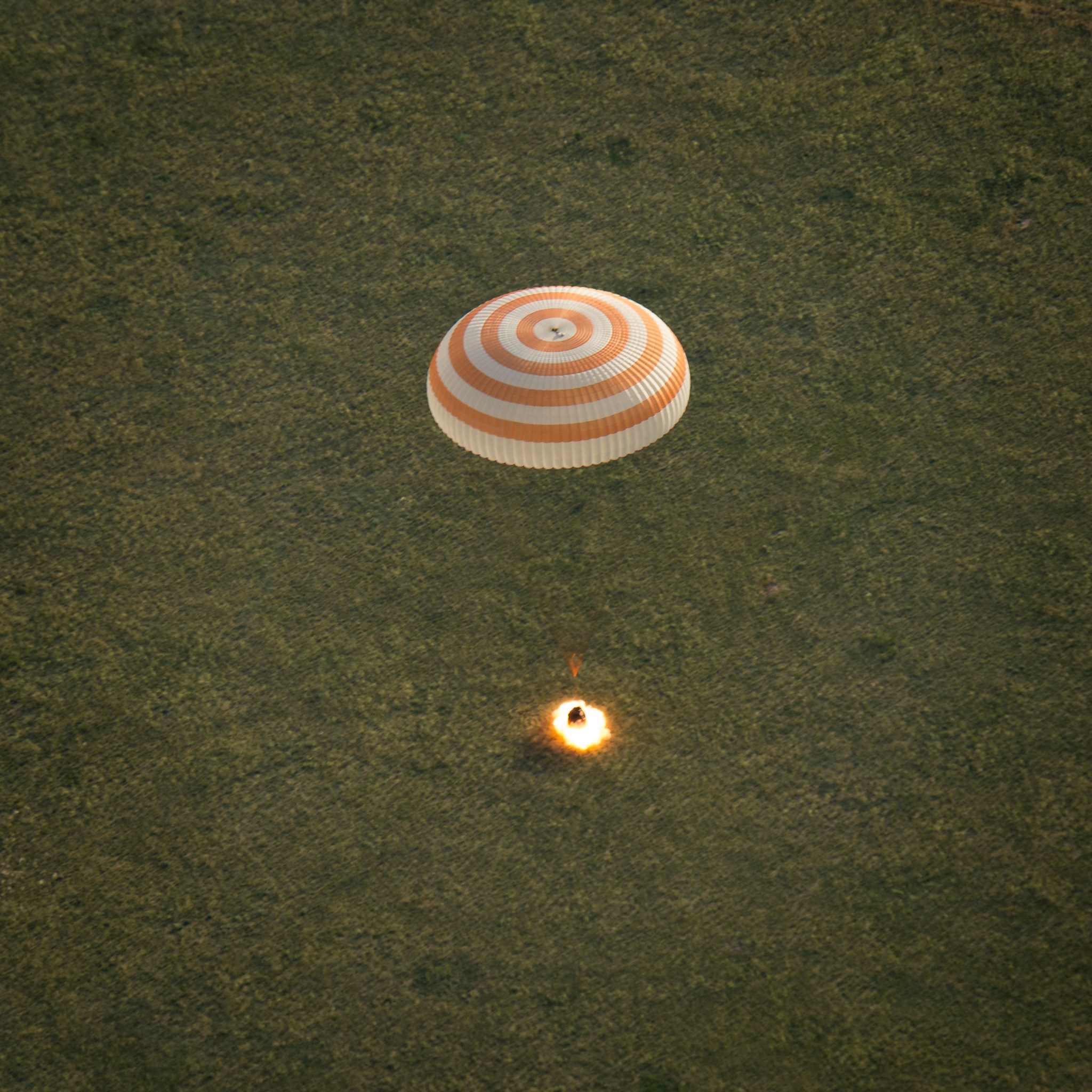
Three crew members of the International Space Station (ISS) returned to Earth Thursday after a 199-day mission that included several spacewalks, technology demonstrations, and hundreds of scientific experiments spanning multiple disciplines, including human and plant biology.
Expedition 43 Commander Terry Virts of NASA, Flight Engineers Anton Shkaplerov of the Russian Federal Space Agency (Roscosmos) and Samantha Cristoforetti of ESA (European Space Agency) touched down at 9:44 a.m. EDT (7:44 p.m., Kazakh time), southeast of the remote town of Dzhezkazgan in Kazakhstan.
During their time aboard the orbiting laboratory, the crew members participated in a variety of research activities focusing on the effects of microgravity on cells, Earth observation, physical science, and biological and molecular science. Their research included the start of a one-year study into human health management over long-duration space travel with the March arrival of NASA astronaut Scott Kelly and Roscosmos cosmonaut Mikhail Kornienko – the One-Year Crew.
team members welcomed three cargo spacecraft during their stay on station. One Russian ISS Progress cargo vehicle docked to the station in February carrying tons of supplies, and Virts assisted with grapple and connection of two SpaceX Dragon deliveries in January and April — the company’s fifth and sixth NASA-contracted commercial resupply missions.
In preparation for the arrival of U.S. commercial crew vehicles, Virts ventured outside the station for three planned spacewalks to make adjustments for new International Docking Adapters (IDA) that can accommodate the spacecraft. The first IDA is scheduled to arrive on SpaceX’s seventh commercial resupply flight later this month.
The crew also had the opportunity to participate in the demonstration of new, cutting-edge technologies such as the Synthetic Muscle experiment, a test of a new polymer that contracts and expands similar to real muscle. This technology has the potential for future use on robots, enabling them to perform tasks that require considerable dexterity but are too dangerous to be performed by humans in space.
The crew engaged in a number of biological studies, including one investigation to better understand the risks of in-flight infections and another studying the effects microgravity has on bone health during long-duration spaceflight. The Micro-5 study used a small roundworm and a microbe that causes food poisoning in humans to study the risk of infectious diseases in space, which is critical for ensuring crew health, safety and performance during long-duration missions. The Osteo-4 study investigated bone loss in space, which has applications not only for astronauts on long-duration missions, but also for people on Earth affected by osteoporosis and other bone disorders.
The returning crew members will celebrate individual milestones in their space exploration careers. With the completion of his second mission, Virts now has spent 212 days in space. Shkaplerov, having completed his second long-duration mission on the station, has spent 364 days in space. Cristoforetti set a new record for single mission duration by a female astronaut with 199 days in space on her first flight, surpassing NASA astronaut Suni Williams’ previous record of 195 days as a flight engineer on Expeditions 14 and 15 from December 2006 to June 2007.
Expedition 44 now is operating the station with Roscosmos’ Gennady Padalka in command. Flight Engineers Scott Kelly of NASA and Mikhail Kornienko of Roscosmos, are continuing station research and operations until three new crewmates arrive. Kelly and Kornienko are on the first joint U.S.-Russian one-year mission, an important stepping stone on NASA’s journey to Mars.
NASA’s Kjell Lindgren, Roscosmos’ Oleg Kononenko and Japan Aerospace Exploration Agency astronaut Kimiya Yui are scheduled to launch from Kazakhstan in late July.
For more information on the International Space Station and its crews, visit:
https://www.nasa.gov/station
For b-roll and other media resources, visit:
https://www.nasa.gov/stationnews
For breaking news and features, follow the station on Twitter using @Space_Station. On Monday, June 15 at 5 p.m., the account and @usairforce will send a link for a live Periscope event the U.S. Air Force is hosting, enabling Virts to continue to tell the world about his mission now that he is back on Earth.
-end-
Kathryn Hambleton
Headquarters, Washington
202-358-1100
kathryn.hambleton@nasa.gov
Dan Huot
Johnson Space Center, Houston
281-483-5111
daniel.g.huot@nasa.gov




























